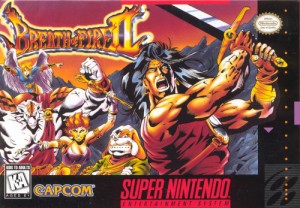Lost Classics: Breath of Fire I and II (SNES, Gameboy Advance, Wii Virtual Console)
by William Talley, filed in Games, Lost Classics on Mar.11, 2009
 Many people know Capcom from their fighting games, most recently, Street Fighter IV. Many others like their classic action games such as Devil May Cry, Mega Man, Bionic Commando, or the soon to be released Resident Evil 5. Older gamers even recall their multitude of beat-em-ups, based on everything from Dungeons and Dragons to the Punisher. However, they aren’t too bad at making role playing games either, as these two Super Nintendo games show. While they stick to the genre’s conventions for the most part, these two games contain some innovative quirks that help the series establish its own identity alongside the Final Fantasies and the Dragon Quests.
Many people know Capcom from their fighting games, most recently, Street Fighter IV. Many others like their classic action games such as Devil May Cry, Mega Man, Bionic Commando, or the soon to be released Resident Evil 5. Older gamers even recall their multitude of beat-em-ups, based on everything from Dungeons and Dragons to the Punisher. However, they aren’t too bad at making role playing games either, as these two Super Nintendo games show. While they stick to the genre’s conventions for the most part, these two games contain some innovative quirks that help the series establish its own identity alongside the Final Fantasies and the Dragon Quests.
Note: None of these guys are anywhere near as cock diesel in the game as they are depicted on the cover. Well, maybe the horse-armadillo guy.
Breath of Fire tells the story of the orphan Ryu, a member of the light dragon clan. Following an attack by the dark dragon clan, his sister has been captured, and he sets out to rescue her. He meets several allies, discovers his powers, and gets caught in a plot to unleash an evil goddess upon the world. The sequel, taking place 500 years later, tells the story of another boy named Ryu (who may or may not be either a descendant or reincarnation of the original). His family disappeared when he was a child. Worse yet, no one remembers who he or his family were. He meets a fellow orphan named Bow, and the two spend the next several years doing odd jobs. One day when the two have reached adulthood, Bow is accused of stealing, and Ryu sets out to clear his name, meeting a host of unique characters in the process and getting swept in another grand adventure.
Breath of Fire plays the same as many other RPGs for the most part. You battle enemies in random encounters, defeat them to gain exp and gold, and then spend the money on weapons items, and armor. However, a few things set this game apart from the rest of the pack. For one, it uses day and night cycles. People will go about their work and business during the day, while they retreat indoors during the night, so it affects gameplay. During battles players can arrange the position of their heroes, even selecting players from the inactive part of the roster. This cones in handy in particularly tough fights. Also, certain characters have skills that can be used on the overworld map. For instance, BOF II character Sten has extensible arms which he can use to pull the team across chasms. There are also hunting and fishing components, and they have even been turned into separate minigames in Breath of Fire II. What really puts this game over the rest of the herd, is the character transformations. The main character Ryu can transform into all sorts of dragons while BOF I character Karn can combine certain characters and create new ones, which even remain with the party after battle. In Breath of Fire II, character merging is done by finding shamans. By combining a character with up to two of the six shamans, he or she can gain new powers. At the least, their sprite will be recolored and they’ll gain a slight stat bonus. At the most, they will gain a new form, complete with new powers. In Breath of Fire 2, players can even design their own hometown. They’ll pick the general design style, and find people with which to populate with. Many of the people you’ll find are normal NPCs, but several of them provide services, such as restoration, shops, and inns. By finding the right people, the player can even get the best ending.
Although it’s more of a cosmetic feature in both games, the overworld and battle music change throughout the two games as well. Although it isn’t as earth shattering as the games other features, anyone who gets tired of hearing the same old tunes during the course of a 40-hour plus game will appreciate the feature.
Both games have been re-released on the Game Boy Advance, complete with new cinematics, redone character portraits, and the ability to trade items over link cable. Breath of Fire II was also re-released on the Virtual Console, and was one of the first RPGs to be released on the service. No doubt that Breath of Fire I (which was originally published in the U.S. by Squaresoft) will be seeing a Virtual Console re-release in the near future as well. Also, the latter 3 installments of the series (III and IV on Playstation 1 and V on Playstation 2) aren’t bad either, and one day I’ll definitely give them a look one day. Until then, fans of classic RPGs should seek these games out. With Capcom’s recent retro revival, I wouldn’t be surprised if we see a new installment of the series sometime in the near future.


 PS3
PS3
 Famicom Dojo
Famicom Dojo KEEP PLAYING
KEEP PLAYING KEEP PLAYING: Rewind
KEEP PLAYING: Rewind Powet Toys
Powet Toys Powetcast
Powetcast Hitchhiker's Guide POWETcast
Hitchhiker's Guide POWETcast














